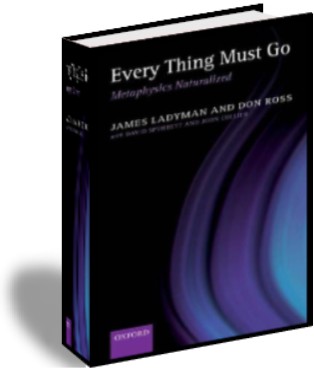Mathematical
Structuralism
Bertrand Russell
puts the case for for what may be deemed a mathematical structural realism when he wrote the following:
“Physics
is mathematical, not because we know so much about the physical
world, but because we know so little: it is only its mathematical
properties that we can discover.” (163)
That
appears to be an admission that mathematics is used in physics
because we don't know everything that is to be known about the
object, condition, event, etc. under description or scrutiny. Mathematical
equations and values are the mere bones of the physics. Mathematics
only deals with structures; not with what have been called “intrinsic
properties”. This position seems to be at odds, then, with the realism of James Ladyman, Don Ross and other contemporary ontic structural realists.
It's here that there are two options available. One, to become a kind
of thing-eliminativist and say, “Every thing must go." Or two,
one can adopt a quasi-Kantian line and say that there are
things-in-themselves (or intrinsic properties); though the problem is
that we don't know anything about them. Indeed, as with option one,
we can eliminate "substances" or things-in-themselves from our
ontology.
Russell
then elaborates on his structural and mathematical ontic realism.
He states the obvious point that “[p]hysics is mathematical”. And
then says that when it comes to the “physical world” it's “only
its mathematical properties” that we have access to. Such
properties are all “we can discover” (163).
The
Maths of Point-instants
In
one place you find Russell speaking about “point-instants” which
seems to be a perfect example of ontic structural realism. Firstly he tell us
that “we can define a point-instant in space-time as a group of
events”. Then he he says that
“the
'points' (or point-instants) that the mathematician needs are not
simple, but are structures composed of events, made up for the
convenience of the mathematician”.
This is an articulation of structural realism, not a realism
about or towards things. Not only that: when Russell tells us that these
structures are “made up for the convenience of the mathematician”,
this too sounds like some kind of constructivism – ontic structural
constructivism! Then again, the word "structural" (or "structuralism") is, in itself, a tacit commitment to some kind of
constructivism.
It
is clear that Russell has taken the idea of a “centre” omitting
radiations from Werner Heisenberg. Russell tells us that
“Heisenberg
regards a piece of matter as a centre from which radiations travel
outward”.
These
radiations constitute the realism of this picture in that “radiations
are supposed really to occur”. However, the irrealism (as it were)
about things (or about centres) is put when Russell argues that the
matter at their centre is reduced to a mere mathematical fiction.
Russell's
Kantianism?
Russell
puts what can be called the Kantian stance on these issues and
problems. Basically, Russell believes that all we have are what he
calls the “effects of a thing-in-itself”. Thus Russell
comes to the conclusion (as contemporary ontic structural realists
have done) that if we only have access to effects (or to external
properties), then why not factor out that distinction between
thing-in-itself (or intrinsic properties) and its effects (i.e.,
external properties).
We
can now ask about those effects. What is left of the
things-in-themselves? In terms of the science of this issue, Russell
writes:
“We
find that energy in various forms spreads outwards from various
centres; we find also that such centres have a certain degree of
persistence, though this persistence is not absolute...”
Prima
facie, this seems like a simple substitution of the word "thing" (or "piece of matter") with the word "center". Instead of a thing “having a
certain degree of persistence”, it's simply these physical centres
which do so. Nonetheless, it can still be said that these centres
are, effectively, things (or pieces of matter). In other words, are we
simply debating the correct usage of words here?
Russell
continues by expressing the basic science of an electron or proton
and why it is that we take them to be things. Thus, in point of fact,
“the
modern physicist faces cheerfully the possibility than an electron
and a proton may mutually annihilate each other, and even suggests
that this may be the main source of the radiant energy of the stars,
because when it happens it makes an explosion”.
Thus
firstly we discover that the electron and proton have some kind of
mutual relation with one another. That alone will raise questions as
to their ontological reality as separate entities. In other words, if
two things - a and b - always have a necessary and
“mutual” relation to one another, then what right have we to see
them as distinct entities in the first place?
That
later possibility is scientifically elaborated upon when Russell
tells us “[w]hat can be asserted” about these matters. He writes:
“When
energy radiates from a center, we can describe the laws of its
radiation conveniently by imagining something in the centre, which we
will call an electron or a proton according to circumstances, and for
certain purposes it is convenient to regard this centre as
persisting, i.e. as not a single point is spacetime but a series of
such points, separated from each other by time-like intervals. All
this, however, is only a convenient way of describing what happens
elsewhere, namely the radiation of energy away from the centre. As to
what goes on in the centre itself, if anything, physics is silent.”
(165)
Whereas
earlier I said that the word "centre" was being used as a substitute
for the word "thing", now Russell speaks of '"spacetime points" instead. Thus
even though Russell says that “what goes on in the centre itself,
if anything, physics is silent”, he still feels comfortable
talking about "spacetime points".
Reference
Russell,
Bertrand. (1927, 1970) An
Outline of Philosophy.











No comments:
Post a Comment